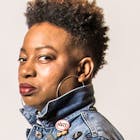LaTasha Rogers was a Los Angeles native who was looking to become a part of a new wave of women in Hip-Hop. The late 1980s saw an explosion of female stars in the famously male-dominated genre of rap music. Salt-N-Pepa had broken big with "Push It" and their debut album Hot, Cool & Vicious and a host of women had emerged in their wake: among them were brash Brooklyn teen MC Lyte, U.K. transplant Monie Love, and New Jersey's Queen Latifah. Alongside groups like J.J. Fad and Oaktown's 357, women were making major noise. On top of that, the West Coast had become a viable locale for rap success. After years of New York City's dominance, California rap by artists like Too $hort, N.W.A. and MC Hammer was selling big.
It was into that climate that MC Trouble landed in the late 1980s.
Meanwhile, Motown was rejuvenating its image under new chief Jheryl Busby. Busby had been the head of Black music at MCA for years, shepherding the careers of chart-toppers like New Edition and Jody Watley. In 1988, Motown founder Berry Gordy sold Motown Record Corporation for $61 million to a Boston venture capital concern and MCA Records; and Busby took over as President. At Motown, Busby wanted to bring the classic house of Hitsville into a more modern era; and in the late 1980s, that meant diving headfirst into new jack swing R&B and Hip-Hop. MC Trouble had originally intended to pursue a career as a singer, but focused on rapping after a local DJ heard her rhyme. Now, she was set to be Motown's first major foray into rap music. The label first pushed the teenager via the What Does It All Mean compilation. Released in 1989 via Motown with Greg Mack of KDAY 1580, the project was meant to announce Motown's new wave.







